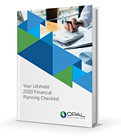Want to Lower Your 2021 Tax Bill? Consider Opportunity Zones
By Michael C. Williams, CPA | August 17, 2021If you’ve ever profited from the sale of a highly appreciated asset, you know what a challenge it can be to minimize the capital gains tax exposure. What starts out as a high-five moment can feel more like a gut punch when you realize that a substantial chunk of that hard-earned money could end up going to the IRS.
Investors—and their financial advisors—have long been on the lookout for ways to reduce the taxes on significant gains. But the options are limited, and each has its own complications… not to mention a few strings attached.

One alternative that’s been getting attention in recent years is called a Qualified Opportunity Zone Fund. Like any investment, it comes with some risks, and we wouldn’t recommend jumping in without getting plenty of guidance. But if you’re facing significant tax payments because of capital gains, it’s a strategy that may be worth exploring.
What Is a Qualified Opportunity Zone Fund?
Qualified Opportunity Zone Funds were introduced in December 2017 as part of the Tax Cuts and Jobs Act. The goal was to motivate eligible taxpayers to reinvest their capital gains in funds that finance the revitalization of economically distressed communities designated as Qualified Opportunity Zones (QOZs).
In order to qualify for the program, a QOZ Fund created by a partnership or corporation must put at least 90% of its capital toward improving eligible properties in certified QOZs. In return, QOZ Fund investors can receive certain tax benefits.
What Are the Tax Benefits for Investors?
An investor typically has 180 days from the date of the sale or exchange of an appreciated property (real estate, stocks, bonds, commodities, art, jewelry, etc.) to reinvest the realized capital gain dollars into a QOZ Fund. The program then provides the following tax benefits:
- Tax deferral through 2026: Long- or short-term capital gains reinvested into a QOZ Fund will be excluded from the investor’s gross taxable income until December 31, 2026, or the date the investor’s interest in the fund is sold or exchanged, whichever comes first.
- Reduction of capital gains taxes: A taxpayer who holds a QOZ Fund investment for five years also will qualify to receive a 10% step-up in the tax basis. (For example, if an investor put $1 million into a fund on December 31, 2021, and held it through December 31, 2026, he or she would pay capital gains rates on only $900,000.)
- Permanent exclusion of taxable income on new gains: Any new capital gains produced through a QOZ Fund investment that is held for at least 10 years will be 100% tax exempt.
- State income tax benefits: Investors may be able to receive similar tax benefits (deferral, reduction and/or exclusion of capital gains taxes) on the state level, depending on where they reside.
Conformity with the program’s tax provisions vary from state to state, and a state’s status may change from year to year. For example, New York State originally chose to fully conform with the QOZ program, which meant investors could defer, reduce and exclude state and local taxes on capital gains reinvested in a QOZ Fund. In April 2021, however, New York lawmakers moved to “decouple” from the federal program, limiting the state and local tax benefits.
New York residents still can take advantage of the program when it comes to their federal taxes. And if the taxpayer holds the QOZ fund investment for at least 10 years, he or she still can exclude the capital gains from the sale on a state and/or city return. But going forward, a resident will not be able to defer or reduce the payment of New York State and/or New York City taxes on capital gains through the QOZ program.
What Are the Risks?
If you like the idea of an investment that’s designed to have a positive social impact while also offering tax benefits and portfolio diversification, a QOZ Fund could be a good fit for you. But this strategy isn’t meant for everyone, and it does carry some risks.
Remember: The designated communities are distressed, and there’s no guarantee a fund’s planned recovery efforts will be a success on your timeline. If the targeted community and businesses don’t gain in value, your investment may not make money, or could even lose money.
There’s also some liquidity risk. To take full advantage of QOZ tax benefits, you must hold the investment for 10 years or more.
Is a QOZ Fund Right for You?
Don’t let the appealing tax incentives alone draw you into making a poor investment. Besides sticking to the investing fundamentals that have worked for you in the past, it’s important to understand how the QOZ program works overall. (The IRS regulations can be complicated, and they’re evolving.) You also should be sure any fund you choose meets the program’s strict criteria.
Your Opal advisor can walk you through the pros and cons of this relatively new way to deal with large capital gains. We can discuss how it compares to the better-known 1031 Exchange and other strategies. We also can talk about the various QOZ Funds available (the options continue to grow), and what to look for when you’re choosing a fund.
There are a couple of deadlines to be aware of if you’re interested in this strategy:
- September 10, 2021: The deadline to invest any 2020 gains recognized through a pass-through entity (partnership or S corporation) Schedule K-1, going back as early as January 1, 2020.
- December 31, 2021: The last day to put money into a QOZ Fund and hold it there for five years (until December 31, 2026) in order to be eligible for the 10% step-up basis.
The first deadline is coming up fast, so it’s important to contact your Opal advisor today to get the individualized guidance you need.
Be a Smart Investor
Stay up-to-date with industry-leading information and news delivered straight to your inbox.
Get our timely insights delivered to your inbox (Blog)
Please remember that past performance may not be indicative of future results. Different types of investments involve varying degrees of risk, and there can be no assurance that the future performance of any specific investment, investment strategy, or product (including the investments and/or investment strategies recommended or undertaken by Opal Wealth Advisors, LLC [“OWA]), or any non-investment related content, made reference to directly or indirectly in this commentary will be profitable, equal any corresponding indicated historical performance level(s), be suitable for your portfolio or individual situation, or prove successful. Due to various factors, including changing market conditions and/or applicable laws, the content may no longer be reflective of current opinions or positions. Moreover, you should not assume that any discussion or information contained in this commentary serves as the receipt of, or as a substitute for, personalized investment advice from OWA. OWA is neither a law firm, nor a certified public accounting firm, and no portion of the commentary content should be construed as legal or accounting advice. A copy of the OWA’s current written disclosure Brochure discussing our advisory services and fees continues to remain available upon request or at www.opalwealthadvisors.com. Please Remember: If you are a OWA client, please contact OWA, in writing, if there are any changes in your personal/financial situation or investment objectives for the purpose of reviewing/evaluating/revising our previous recommendations and/or services, or if you would like to impose, add, or to modify any reasonable restrictions to our investment advisory services. Unless, and until, you notify us, in writing, to the contrary, we shall continue to provide services as we do currently. Please Also Remember to advise us if you have not been receiving account statements (at least quarterly) from the account custodian.



